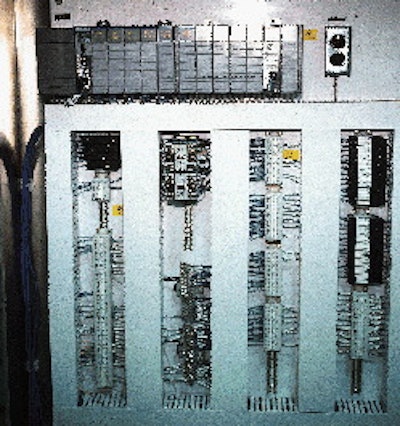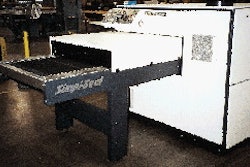When Amway relocated a five-year-old personal care packaging line to become Line 2 of its new $17 million Personal Care Manufacturing Facility, management decided to boost the line's efficiency by investing in state-of-the-art controls. First, each machine's programmable logic controller was replaced with a new SLC 5/04 networkable PLC from Allen-Bradley (Milwaukee, WI). Next, all of these PLCs were connected to a Data Highway Plus communications network, also from Allen-Bradley. The network permits each PLC to freely exchange information with other PLCs on the packaging line. The line itself packages lotions, shampoos and other products at Amway's expansive headquarters and manufacturing campus in Ada, MI. Amway also added a touchscreen human-machine interface (HMI), also known as an operator interface. From the HMI, located at the filler, the operator can view the status of and control any piece of equipment on the line. (For details on how the HMI also contributes to increased line efficiency, see story, p. 34.) Amway's arrangement is notable for its departure from tradition, where PLCs on a packaging line communicate with one another via hard-wired input/output points. For example, a capper would signal a fault condition to the filler via a wire running from an output on the capper's PLC to the input on the filler's PLC. That uses up an I/O point in each PLC. "You'd have to run a wire for every piece of information you would want to convey from the capper to the filler," says Jay Mol, electrical engineer at the personal care plant. Instead, the Data Highway Plus network relies on a single network conduit over which all the PLCs on Line 2 can freely communicate. With a network, a PLC's control logic can be altered to send or receive information to or from other PLCs without being dependent on a string of wire being run first. "You can make changes easily in software rather than pay for $500 to $3ꯠ in rewiring costs," says Mol. Easier troubleshooting As a result of upgrading the controls and networking the line's packaging equipment, a principal benefit is easier troubleshooting. From his office, Mol can examine or alter the ladder logic programming or data in any PLC on the network. This ability can translate into a quicker troubleshooting response if an electrician calls him from the packaging floor with a problem. "I can log onto the network and immediately start taking care of the problem," says Mol. Otherwise, Mol would have to grab his computer, run out onto the plant floor, plug in, and wait for his computer to boot up. He concedes that in some cases he still must do this, depending on the nature of the problem. "But I can do an initial checkout right here instantaneously," he says. There's also a reduction in point-to-point wiring, which translates into a savings in wiring time, especially for making any changes to the line. Had the same line been completely hard-wired, Mol estimates an additional four to five PLC I/O modules-plus an equal number of terminal blocks that connect the wiring-would have been required in the line's control cabinet. Less hard-wired I/O also means fewer potential failure points. Since each terminal block has 18 connection points, that means as many as 90 potential failure points were eliminated. However, Mol points out that the network doesn't completely eliminate the need for hard-wiring. OSHA requires that all emergency stop buttons and safety-related signals be hard-wired so that the machines shut off instantly rather than risk even the smallest chance for a potential delay over the network. A final benefit of the network is the ability to automate the process of data acquisition. A computer tied into the packaging line automatically logs much of the production data (see sidebar, p. 32), which eliminates log sheets and clipboards. Main line PLC Line 2 has a main line PLC-also connected to the network-that controls all line functions that are not controlled by individual machines. That consists mainly of controlling the variable frequency drive (VFD) conveyors in between each packaging machine. The "highway" itself consists of a twisted-pair two-conductor serial cable that links one PLC (or PC, in the case of the HMI, for example) to the next, daisy-chain fashion. "Data Highway Plus" actually refers to the communications standard or protocol that devices on the network use to transmit digital information to one another. Each device on the network-known in network parlance as a node-has its own unique "address," like an address of each house on a street. When one node (for example, the HMI PC) wants to talk to another (say, the main line PLC), it sends a message out onto the network, which all nodes can see. The node with the proper address knows that the message is meant for it. On Line 2, the machines that were taking most advantage of the network at the time of Packaging World's visit were the filler, capper, the hold tank system that supplies the filler, and the plant's clean-in-place solution supply system that works in tandem with the filler's CIP system. As an example of how the packaging line uses the network to exchange information, consider how the filler interacts with the hold tank. The filler uses the network to signal the hold tank to send more product when the filler bowl reaches a low point. Conversely, when the hold tank reaches a low point, it uses the network to signal the HMI to inform the operator in plenty of time. At the final critical moment when the hold tank empties, it signals the filler to shut down to prevent it from sucking air through the supply line. In the past, the filler would simply shut down with no advance warning. The operator would be left to deduce that the cause of the shutdown was an empty filler bowl, and the cause of that was an empty hold tank. Economics The main component of the investment in the network for Line 2 consisted of the new SLC 5/04 PLCs. Unlike some of Amway's older PLCs, this model can be connected directly to the network without the need for interface devices. Mol says that interface devices were ruled out because some of them would have cost almost as much as a new PLC. And for some of Amway's older PLCs, there was simply no way to upgrade them to connect to the Data Highway Plus network. SLC 5/04 PLCs list for just under $2ꯠ apiece, though PLCs aren't typically sold at list price, Mol says. Amway also specified SLC 5/04 PLCs for the new equipment on the plant's other two personal care filling lines, which also fill shampoo, lotions and other products (see PW, Jan. '98, p. 30 ). That equipment would have needed PLCs anyway, so there was no additional cost involved. Apart from the investment in new PLCs, the economics of the network infrastructure itself are extremely modest, according to Mol. Engineering and wiring time is minimal since the cables simply plug into dedicated ports on the PLCs. The other main component of Amway's controls upgrade was its HMI on Line 2. Though all pieces of equipment are on the network-including all the PLCs from the plant's other two packaging lines-not all of them are currently programmed to pass information to one another. That's being done on an as-needed basis, according to Mol. He admits some additional investment in the network infrastructure will be required as traffic on the network increases. "The more traffic you put on the network, the slower it gets," says Mol. For that reason, Amway plans in the future to segregate each packaging line into its own communications network so that they don't interfere with one another. Inter-network connectivity will be preserved by adding special network routing devices called gateways. Eventually, Mol foresees a time when Amway's network will be upgraded to Ethernet, a computer industry standard communications protocol that's been penetrating the industrial automation market. The speed of Ethernet is 10 megabits/ sec, about 170 times faster than 57.6 kilobaud or kilobits per second (kbps), which is the speed of Data Highway Plus. However, Allen-Bradley says its protocol is designed more expressly for real-time communications than is Ethernet, whose origins are in less mission-critical applications such as general office automation. A-B also says the cost per node of Data Highway Plus is less than Ethernet, and Mol agrees. For the near future, Mol doesn't foresee the need to replace the SLC 5/04 PLCs. "For now, the speed they're communicating at is fine."
























